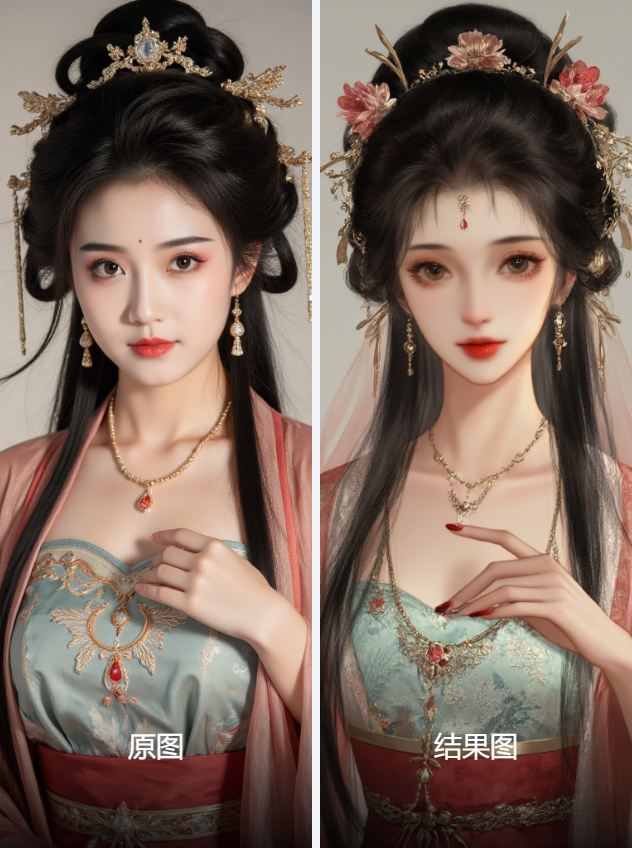"From Pixels to Brushstrokes: A Deep Dive into Traditional Chinese Art Generation"
Workflow Overview

This JSON file describes a workflow based on ComfyUI, designed to transform images into traditional Chinese ancient-style hand-drawn art. The workflow integrates multiple models and techniques, including LoRA models, VAE encoding/decoding, image generation, and image comparison. Below is an overview of the main components and functionalities of the workflow:
Main Nodes and Functions
LoadImage (Node 94):
Function: Loads the input image (e.g.,
318451407-39ff4f0e4f58bcbaa8c082872dace30d46c2275b6b089359476b4c3ae1e2d638 (1).png) for further processing.Output: Image data.
CheckpointLoaderSimple (Node 114):
Function: Loads the base model (e.g.,
【FLUX】绪儿-红蓝幻想_FB8V1) for image generation.Output: Provides model data.
CR LoRA Stack (Node 156):
Function: Loads multiple LoRA models to enhance the style and details of the image.
Loaded LoRA Models:
唯美古风插画风格_v1(weight 1)古风唯美文游乙游角色立绘模型_v1(weight 1)
Output: Provides a stack of LoRA models.
easy loraStackApply (Node 153):
Function: Applies the LoRA model stack to the base model, generating an enhanced model.
Output: Provides the enhanced model.
VAELoader (Node 56):
Function: Loads the VAE model for image encoding and decoding.
Loaded Model:
ae.sft.
VAEEncode (Node 104):
Function: Encodes the input image into a latent image.
Input: Image and VAE model.
Output: Latent image.
CLIPTextEncode (Node 54):
Function: Encodes text prompts into conditions understandable by the model.
Input: CLIP model and text prompts.
Output: Condition data for image generation.
Positive Prompt: Describes an Asian man wearing traditional black and gold attire, with a white gradient background.
FluxSamplerParams+ (Node 102):
Function: Generates the final latent image using the model, condition data, and latent image.
Input: Model, condition data, latent image, and LoRA parameters.
Output: Generated latent image and sampling parameters.
VAEDecode (Node 55):
Function: Decodes the latent image into a visible image.
Input: Latent image and VAE model.
Output: Generated image.
SaveImage (Node 41):
Function: Saves the final generated image.
Input: Generated image.
Output: None.
Image Comparer (rgthree) (Node 105):
Function: Compares the original image with the generated image to showcase the processing effect.
Input: Original image and generated image.
Output: None.
Florence2ModelLoader (Node 119):
Function: Loads the Florence2 model for generating image descriptions.
Loaded Model:
thwri/CogFlorence-2-Large-Freeze.
Florence2Run (Node 118):
Function: Uses the Florence2 model to generate descriptions of the image.
Input: Image and Florence2 model.
Output: Image description (caption).
ShowText|pysssss (Node 120):
Function: Displays the image description generated by the Florence2 model.
Input: Image description.
Output: None.
Workflow Summary
Image Loading and Encoding:
Loads the input image and encodes it into a latent image.
Model Loading and Enhancement:
Loads the base model and LoRA models, generating an enhanced model.
Text Encoding and Condition Generation:
Encodes text prompts into condition data for image generation.
Image Generation:
Uses the model, condition data, and latent image to generate the final latent image.
Decodes the latent image into a visible image.
Image Saving and Comparison:
Saves the generated image and compares it with the original image.
Image Description Generation:
Uses the Florence2 model to generate and display image descriptions.
Workflow Features
Traditional Chinese Ancient-Style Transformation:
Converts ordinary images into traditional Chinese ancient-style hand-drawn art using LoRA models (e.g.,
唯美古风插画风格_v1and古风唯美文游乙游角色立绘模型_v1).
High-Quality Image Generation:
Uses the FluxSamplerParams+ node to generate high-quality latent images.
Image Description Generation:
Uses the Florence2 model to generate image descriptions, helping users understand the image content.
Image Comparison:
Provides an image comparison feature, allowing users to view the effects before and after processing.
Applicable Scenarios
This workflow is suitable for the following scenarios:
Traditional Chinese Ancient-Style Art Creation: Converts ordinary images into traditional Chinese ancient-style hand-drawn art, suitable for art creation and game design.
Image Style Transformation: Quickly transforms image styles using LoRA models.
Image Description Generation: Generates image descriptions to help users understand the image content.
Summary
This workflow combines LoRA models and the Florence2 model to transform ordinary images into traditional Chinese ancient-style hand-drawn art through multi-stage image generation and processing. The workflow also provides image description generation and comparison features, facilitating further processing and evaluation of results.